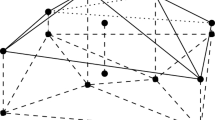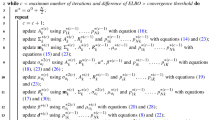Abstract
In the present study, we consider the problem of estimating a function of scale parameter \(\ln \sigma \) under an arbitrary location invariant bowl-shaped loss function, when location parameter \(\mu \) is unknown. Various improved estimators are proposed. Inadmissibility of the best affine equivariant estimator (BAEE) of \(\ln \sigma \) is established by deriving a Stein-type estimator. This improved estimator is not smooth. We derive a smooth estimator improving upon the BAEE. Further, the integral expression of risk difference (IERD) approach of Kubokawa is used to derive a class of improved estimators. To illustrate these results, we consider two specific loss functions: squared error and linex loss functions, and derive various estimators improving upon the BAEE. Finally, a simulation study has been carried out to numerically compare the risk performance of the improved estimators.
Similar content being viewed by others
References
Al-Mosawi RR, Khan S (2018) Estimating moments of a selected Pareto population under asymmetric scale invariant loss function. Stat Pap 59(1):183–198
Arshad M, Misra N (2016) Estimation after selection from exponential populations with unequal scale parameters. Stat Pap 57(3):605–621
Beadle E, Schroeder J, Moran B, Suvorova S (2008) An overview of Renyi entropy and some potential applications. In: Signals, Systems and Computers, 2008 42nd Asilomar Conference on, IEEE, pp. 1698–1704
Bobotas P, Iliopoulos G, Kourouklis S (2012) Estimating the ratio of two scale parameters: a simple approach. Ann Inst Stat Math 64(2):343–357
Brewster JF (1974) Alternative estimators for the scale parameter of the exponential distribution with unknown location. Ann Stat 2(3):553–557
Brewster JF, Zidek J (1974) Improving on equivariant estimators. Ann Stat 2(1):21–38
Brown L (1968) Inadmissibility of the usual estimators of scale parameters in problems with unknown location and scale parameters. Ann Math Stat 39(1):29–48
Brown LD (1966) On the admissibility of invariant estimators of one or more location parameters. Ann Math Stat 37(5):1087–1136
Cover TM, Thomas JA (2012) Elements of information theory. Wiley, Hoboken
Grubbs FE (1971) Approximate fiducial bounds on reliability for the two parameter negative exponential distribution. Technometrics 13(4):873–876
Hanawal MK, Sundaresan R (2011) Guessing revisited: a large deviations approach. IEEE Trans Inform Theory 57(1):70–78
Hughes M, Marsh J, Arbeit J, Neumann R, Fuhrhop R, Wallace K, Thomas L, Smith J, Agyem K, Lanza G (2009) Application of Renyi entropy for ultrasonic molecular imaging. J Acoust Soc Am 125(5):3141–3145
Jizba P, Kleinert H, Shefaat M (2012) Rényi’s information transfer between financial time series. Phys A 391(10):2971–2989
Kang SB, Cho YS, Han JT, Kim J (2012) An estimation of the entropy for a double exponential distribution based on multiply type-II censored samples. Entropy 14(2):161–173
Kayal S, Kumar S (2011) Estimating the entropy of an exponential population under the linex loss function. J Indian Stat Assoc 49:91–112
Kayal S, Kumar S (2013) Estimation of the Shannon’s entropy of several shifted exponential populations. Stat Probab Lett 83(4):1127–1135
Kayal S, Kumar S, Vellaisamy P (2015) Estimating the Rényi entropy of several exponential populations. Braz J Probab Stat 29(1):94–111
Kubokawa T (1994) A unified approach to improving equivariant estimators. Ann Stat 22(1):290–299
Misra N, Choudhary P, Dhariyal I, Kundu D (2002) Smooth estimators for estimating order restricted scale parameters of two gamma distributions. Metrika 56(2):143–161
Misra N, Singh H, Demchuk E (2005) Estimation of the entropy of a multivariate normal distribution. J Multivar Anal 92(2):324–342
Nematollahi N (2017) Admissible and minimax estimation of the parameter of the selected Pareto population under squared log error loss function. Stat Pap 58(2):319–339
Pan M, Zhang F (2017) Analysis of the \(\alpha \)-Renyi entropy and its application for medical image registration. Biomed Eng 29(03):1750020
Petropoulos C (2006) Estimation of a quantile in a mixture model of exponential distributions with unknown location and scale parameters. Sankhyā 68(2):240–251
Petropoulos C (2017) Estimation of the order restricted scale parameters for two populations from the Lomax distribution. Metrika 80(4):483–502
Petropoulos C, Kourouklis S (2005) Estimation of a scale parameter in mixture models with unknown location. J Stat Plan Inference 128(1):191–218
Principe JC, Xu D, Fisher J (2000) Information theoretic learning. Unsuperv Adapt Filter 1:265–319
Rényi A (1961) On measures of entropy and information. In: Proceedings of the Fourth Berkeley Symposium on Mathematical Statistics and Probability, Volume 1: Contributions to the Theory of Statistics, The Regents of the University of California
Seo JI, Kang SB (2014) Entropy estimation of generalized half-logistic distribution (GHLD) based on type-II censored samples. Entropy 16(1):443–454
Seo JI, Kim Y (2017) Objective Bayesian entropy inference for two-parameter logistic distribution using upper record values. Entropy 19(5):208
Shannon CE (1948) A mathematical theory of communication. Bell Syst Techl J 27:379–423
Stein C (1956) Inadmissibility of the usual estimator for the mean of a multivariate normal distribution. In: Proceeding of the Third berkeley symposium on mathematical statistics and probability. 1:197–206
Stein C (1964) Inadmissibility of the usual estimator for the variance of a normal distribution with unknown mean. Ann Inst Stat Math 16(1):155–160
Tripathi YM, Petropoulos C, Sultana F, Rastogi MK (2018) Estimating a linear parametric function of a doubly censored exponential distribution. Statistics 52(1):99–114
Acknowledgements
The authors sincerely wishes to thank the editor and the anonymous reviewers for the suggestions which have considerably improved the content and the presentation of the paper.
Author information
Authors and Affiliations
Corresponding author
Appendix
Appendix
Lemma 6.1
Let a, b, r and \(\eta \) be positive real numbers with \(0<a<b\) and \(a_0\in (0,1]\). Then, the function
is increasing in \(z>0\).
Proof
Differentiating M(z) with respect to z we have
Now, \(M^{\prime }(z)>0\) if
which is equivalent to
Further, \(te^{-zt}\left( a_0-e^{-tz}\right) ^{-1}\) is decreasing in t. Hence, under the assumption made, we obtain \(M^{\prime }(z)>0.\) \(\square \)
Lemma 6.2
Let r and \(r_1\) be positive real numbers such that \(0<r_1<r\). Then, the function
is nonincreasing in \(x>0\).
Proof
The proof is similar to that of Lemma 6.1. \(\square \)
Lemma 6.3
Let r and \(\lambda \) be positive real numbers. Then, the function
is increasing in \(y\in {\mathbb {R}}\).
Proof
Differentiating G(y) with respect to y, and then further simplification leads to \(G^{\prime }(y)>0\). \(\square \)
Rights and permissions
About this article
Cite this article
Patra, L.K., Kayal, S. & Kumar, S. Estimating a function of scale parameter of an exponential population with unknown location under general loss function. Stat Papers 61, 2511–2527 (2020). https://doi.org/10.1007/s00362-018-1052-7
Received:
Revised:
Published:
Issue Date:
DOI: https://doi.org/10.1007/s00362-018-1052-7




